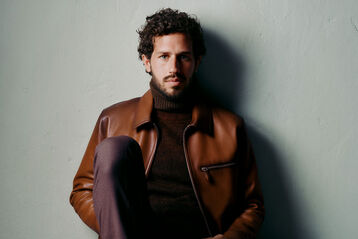
The legend goes that Andy Warhol wore them with white socks. Ah, those Americans… The iconic loafer from the brand Berluti now bears his first name. It is historically simple, like his velvet pouch with a yellow banana. Warhol didn’t bother with complications. Its design—a high vamp with a square toe—evokes the shoes of a musketeer. Did Andy want to be the d’Artagnan of the Factory? The first pair of Andys I acquired was brown with a green patina.
What captivated me was that unnatural square toe. To mock a bad football player, people say he has “square feet.” My friends used to tease me about my wooden shoes. It’s a dandy’s requirement: having square feet is my art of living. The autumn-hued patina gave my shoes a discreet audacity. I felt as if I were constantly walking on fallen leaves. Thirty years later, I still wear that pair, which changes color with every step I take.
As the world becomes more uniform, my way of resisting is to avoid wearing the same shoes as everyone else. Snobbery is a political act: refusing to submit to wardrobe standardization. Each patina makes every Andy unique in the world. The gleam of the polish is the customization of this pedestrian vehicle. I own other Andy loafers: a black pair with a dark red patina and a light beige pair with a darker toe, which I wore when I remarried in the Bahamas.
The comfort is such that I wear them barefoot, like leather espadrilles, with sand as socks, and preferably with ripped jeans. I have often woken up in unknown apartments, wearing dirty clothes, but saved by my loafers. The Andys are the safety net of nocturnal trapeze artists.

I remember my first visit to Olga Berluti’s lair at 26, rue Marbeuf. At the time, I was a trendy advertiser and all my colleagues wore white sneakers. Timidly, I tried on a few pairs. That’s when Olga told me that in 1963, the king of Pop Art had designed this mythical shoe on a corner of a table, which had to be square as well. Olga made it with rebellious cowhide, rubbed against barbed wire, leaving traces of scarification.
The idea of a loafer in subversive cowhide remained. Andy’s style infected me: I was thirty and fancied myself a model of transgression while walking down the Champs-Élysées toward the Travellers Club in a velvet suit. This shoe is like a fine wine; it improves with age. One wishes the same could be said of oneself. Olga taught me to polish my heels by spitting on them—because luxury is also a matter of saliva—or by pouring Dom Pérignon Rosé into the polish.
This way, your Andys will be scented and as tipsy as you are. During long figure-skating sessions in the back room of rue Marbeuf, the circular cloth turned the loafers into Venetian mirrors. Walking is an art. What I liked about Olga was her seriousness. She was deadpan, and I adore people who are funny without smiling. At the time, I didn’t like being seduced because selling was my dreadful job.
The moral of this story is that you shouldn’t mess around with your feet. Walking is not a gesture to take lightly. Let’s be proud: standing upright is what distinguishes us from primates. Andy Warhol said, “Beauty is a proof of intelligence.” Elegance doesn’t happen by chance; “sprezzatura” is a very studied nonchalance. One must be chic without trying to be. Thank you for not repeating it to anyone: nonchalance is a well-kept secret. We need structures to ruin our lives with talent.
You don’t buy an Andy; you adopt it. You don’t wear it; you inhabit it. And you enter the very closed caste of those who have understood that life is a party and style is what remains when you’ve lost everything. Especially your bank account after buying this little marvel. But that’s another story.



